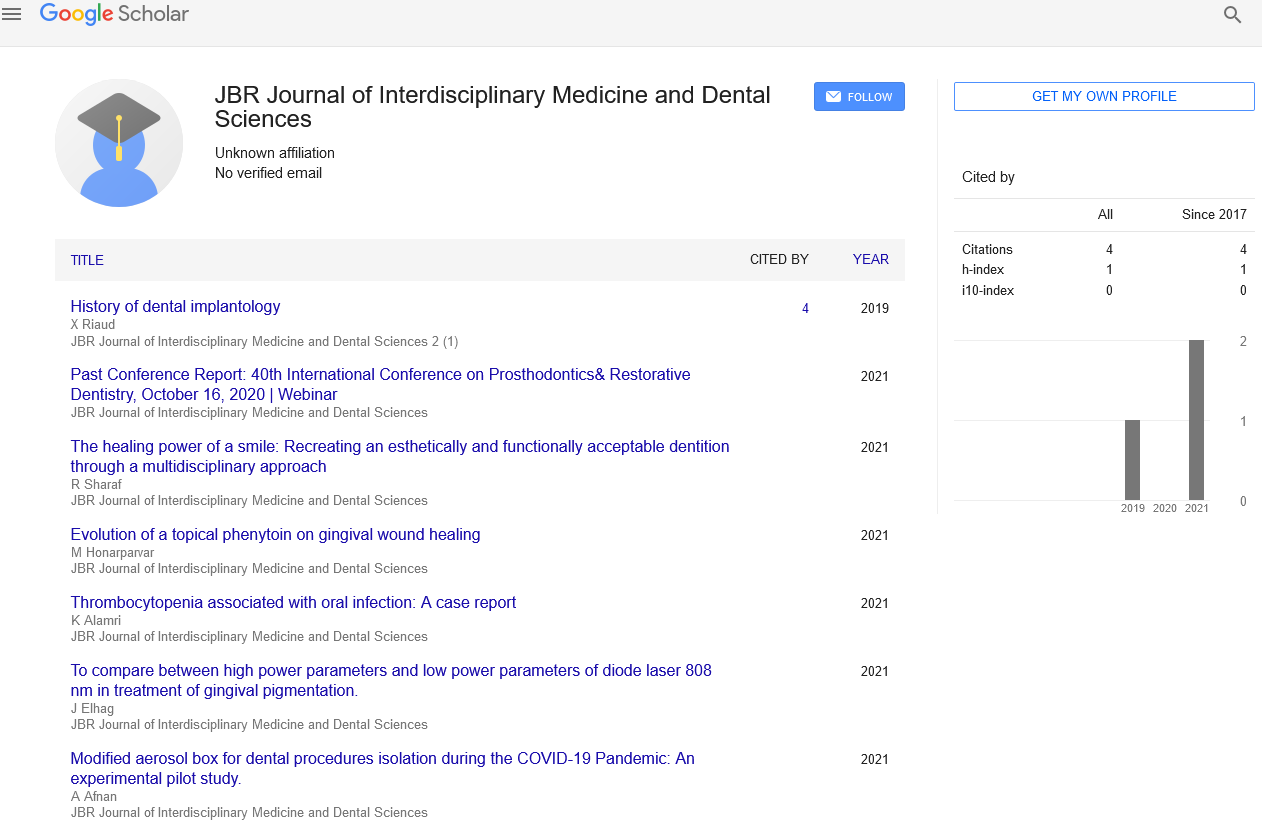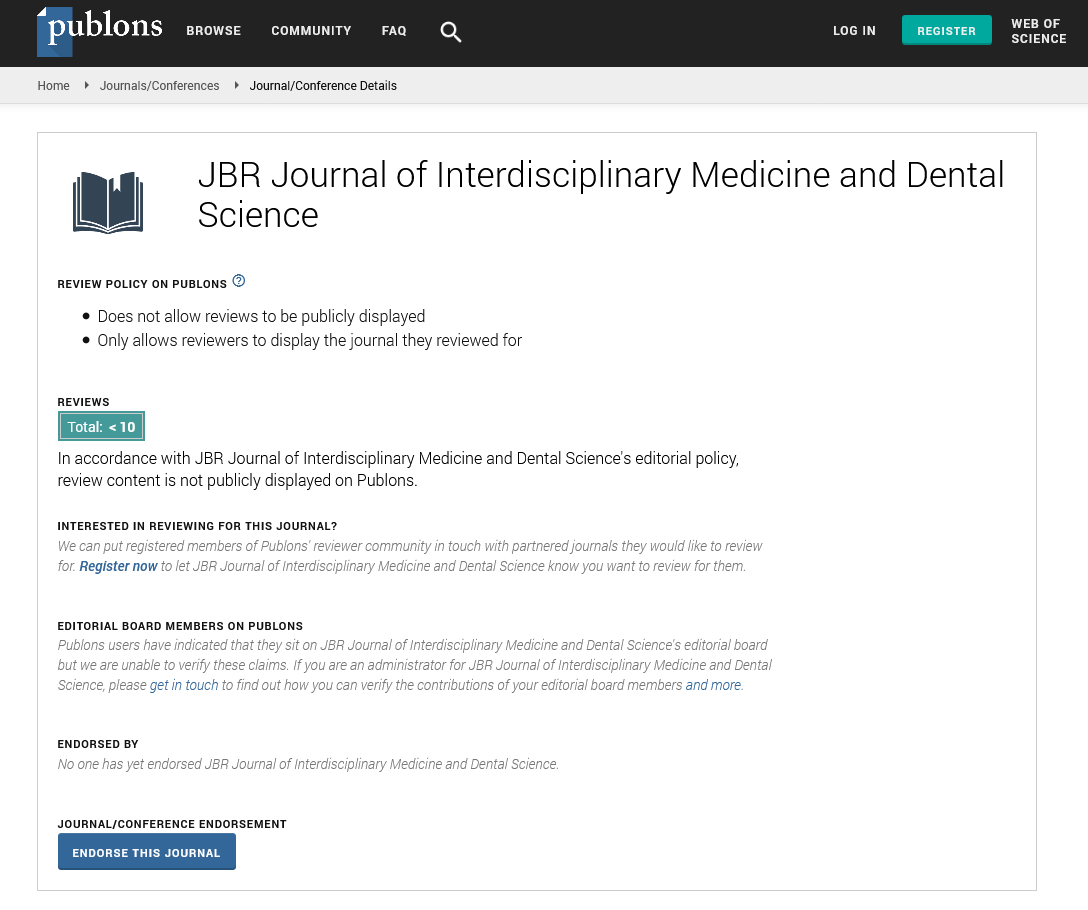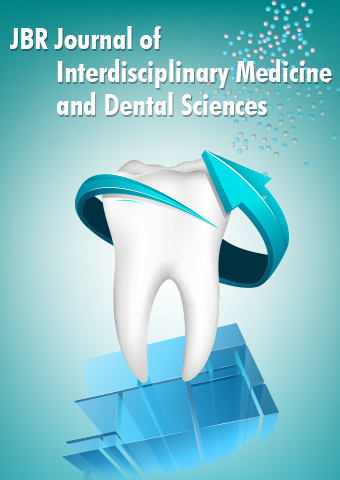Editorial - JBR Journal of Interdisciplinary Medicine and Dental Sciences (2023) Volume 6, Issue 3
The Advancements and Importance of Dental Radiology in Modern Dentistry
John Nicholson*
Department of pharmacology, Australia
Department of pharmacology, Australia
E-mail: john_nson43@gmail.com
Received: 01-May-2023, Manuscript No. jimds-23-100153; Editor assigned: 04-May-2023, PreQC No. jimds-23-100153 (PQ); Reviewed: 18-May-2023, QC No. jimds-23-100153; Revised: 23-May-2023, Manuscript No. jimds-23-100153 (R); Published: 30-May-2023, DOI: 10.37532/2376- 032X.2023.6(3).55-57
Abstract
Dental radiology, also known as dental imaging or dental radiography, is a vital component of modern dentistry. This article highlights the advancements and importance of dental radiology in the field of dentistry. Dental radiographic imaging techniques capture detailed images of teeth, jaws, and surrounding structures, providing valuable information for accurate diagnosis, treatment planning, and monitoring of oral health conditions. The importance of dental radiology lies in its ability to visualize and assess dental conditions that are not easily visible to the naked eye, enabling early detection of dental problems, evaluating tooth development and growth, and assessing oral structures. Over the years, dental radiology has witnessed significant advancements, such as digital radiography, cone beam computed tomography (CBCT), intraoral scanners, and image enhancement and analysis software. These advancements have revolutionized dental imaging by offering reduced radiation exposure, faster image acquisition, enhanced image quality, and precise diagnostic capabilities. The continuous progress in dental radiology is expected to further enhance dental practices, leading to safer, more efficient, and patientcentered dental care.
Keywords
Dental radiology • Dental imaging • Dental radiography • Modern dentistry • Treatment planning
Introduction
Dental radiology, also known as dental imaging or dental radiography, has become an indispensable tool in modern dentistry. Through various imaging techniques, dental radiology allows dentists to capture detailed images of teeth, jaws, and surrounding structures, providing crucial information for accurate diagnosis, treatment planning, and monitoring of oral health conditions [1]. The advancements in dental radiology have significantly improved the diagnostic capabilities and patient care in dentistry. The importance of dental radiology lies in its ability to visualize and assess dental conditions that may not be readily visible to the naked eye. By analysing radiographic images, dentists can detect and diagnose a wide range of dental issues, including tooth decay, gum disease, infections, and abnormalities in tooth alignment [2]. Early detection of these problems enables timely intervention, preventing the progression of oral diseases and reducing the need for invasive treatments. Furthermore, dental radiology plays a vital role in evaluating tooth development and growth, particularly in children. It helps identify potential orthodontic issues, such as malocclusion or impacted teeth, allowing for timely intervention and optimal dental health outcomes. Additionally, radiographic images assist in the assessment of oral structures such as the jawbone, sinuses, and Temporomandibular joint (TMJ), providing essential information for dental implant planning, orthodontic treatments, and oral surgeries. In recent years, dental radiology has witnessed remarkable advancements, driven by technological innovations [3]. Traditional film-based imaging systems have been replaced by digital radiography, which utilizes digital sensors to capture and display images on a computer screen. This digital approach offers numerous benefits, including reduced radiation exposure, faster image acquisition, enhanced image quality, and the ability to store and share images electronically [4]. Another significant advancement is the cone beam computed tomography (CBCT), a three-dimensional imaging technique that provides detailed, high-resolution images of dental structures. CBCT offers a comprehensive view of the teeth, bone, nerves, and soft tissues, making it invaluable for implant planning, orthodontics, and complex surgical procedures. Moreover, the advent of intraoral scanners has revolutionized dental radiology by creating three-dimensional digital models of a patient’s teeth and oral structures. These scanners eliminate the need for traditional impression materials, offering a more comfortable experience for patients and facilitating the creation of precise dental restorations [5]. Furthermore, image enhancement and analysis software have been developed to improve the quality and analysis of dental radiographic images. These software tools allow for image adjustment, measurement of distances and angles, highlighting of specific areas, and integration with patient records for effective treatment planning and follow-up.
Discussion
Dental radiology, also known as dental imaging or dental radiography, plays a crucial role in modern dentistry. It involves the use of various imaging techniques to capture detailed images of teeth, jaws, and surrounding structures. These radiographic images provide invaluable information to dentists, assisting in accurate diagnosis, treatment planning, and monitoring of oral health conditions. Over the years, dental radiology has witnessed significant advancements, leading to safer, more efficient, and highly precise imaging procedures. This article explores the importance of dental radiology and highlights some of the advancements in this field.
Importance of dental radiology
Dental radiology is an indispensable tool in dental practices, as it helps dentists visualize and assess conditions that are not easily visible to the naked eye. Here are some key reasons why dental radiology holds immense importance:
Diagnosis and treatment planning: Dental radiographs enable dentists to diagnose a wide range of dental conditions, such as tooth decay, gum disease, infections, and abnormalities in tooth alignment [6]. By analysing these images, dentists can create effective treatment plans and provide appropriate care to their patients.
Early detection of dental problems: Dental radiography can detect dental issues in their early stages, even before they become symptomatic. Early detection allows for timely intervention, preventing the progression of oral diseases and reducing the need for invasive treatments.
Evaluation of tooth development and growth: Dental radiology is particularly useful in assessing the development and eruption of teeth in children. It aids in identifying potential orthodontic problems, such as malocclusion or impacted teeth, enabling timely intervention for optimal dental health.
Assessment of oral structures: Radiographic images help dentists evaluate the condition of surrounding structures like the jawbone, sinuses, and Temporomandibular joint (TMJ). This information is vital in planning dental implants, orthodontic treatments, and oral surgeries [7].
Advancements in dental radiology: Technological advancements have revolutionized dental radiology, enhancing its diagnostic capabilities and patient experience. Here are a few notable advancements in this field:
Digital radiography: Digital radiography has replaced traditional film-based imaging systems. It involves the use of digital sensors that capture images and instantly display them on a computer screen [8]. Digital radiography offers numerous benefits, including reduced radiation exposure, faster image acquisition, enhanced image quality, and the ability to store and share images electronically.
Cone beam computed tomography (CBCT): CBCT is a three-dimensional imaging technique that provides detailed, high-resolution images of dental structures. It offers a more comprehensive view of the teeth, bone, nerves, and soft tissues, making it invaluable for implant planning, orthodontics, and complex surgical procedures.
Intraoral scanners: Intraoral scanners use advanced optical technology to create threedimensional digital models of a patient’s teeth and oral structures. These scanners eliminate the need for traditional impression materials, offering a more comfortable experience for patients and facilitating the creation of precise dental restorations [9].
Image enhancement and analysis software: Software tools have been developed to enhance and analyse dental radiographic images. These programs allow for image adjustment, measurement of distances and angles, highlighting of specific areas, and integration with patient records for effective treatment planning and follow-up [10].
Conclusion
Dental radiology has emerged as a cornerstone of modern dentistry, playing a crucial role in accurate diagnosis, treatment planning, and monitoring of oral health conditions. The advancements in dental radiology have revolutionized the field, enabling dentists to visualize and assess dental issues that may not be easily visible to the naked eye. By utilizing various imaging techniques, such as digital radiography, cone beam computed tomography (CBCT), and intraoral scanners, dental professionals can offer enhanced diagnostic capabilities, reduced radiation exposure, and improved patient care. The importance of dental radiology lies in its ability to detect dental problems in their early stages, facilitating timely intervention and preventing the progression of oral diseases. It also plays a vital role in evaluating tooth development and growth, aiding in the identification of orthodontic issues and ensuring optimal dental health outcomes. Furthermore, dental radiology enables the assessment of oral structures, providing crucial information for dental implant planning, orthodontic treatments, and oral surgeries. Technological advancements, such as digital radiography, have transformed the field of dental imaging by offering benefits like faster image acquisition, enhanced image quality, and electronic storage and sharing of images. Cone beam computed tomography (CBCT) provides detailed three-dimensional images, enabling comprehensive assessments of dental structures. Intraoral scanners have improved patient comfort and facilitated the creation of precise dental restorations. Additionally, image enhancement and analysis software have enhanced the quality and analysis of radiographic images, facilitating effective treatment planning and follow-up. As dental radiology continues to evolve, it holds the potential to further advance dental practices, leading to safer, more efficient, and patient-centered dental care. With on-going research and technological advancements, dental professionals can expect even greater diagnostic precision and improved treatment outcomes. The advancements in dental radiology have significantly enhanced the importance and impact of this field in modern dentistry. Through the utilization of advanced imaging techniques and software, dental professionals can provide accurate diagnoses, effective treatment plans, and personalized care to their patients. Dental radiology will continue to be a vital tool, empowering dentists to deliver high-quality oral healthcare and contribute to the overall wellbeing of their patients.
References
- Bromley SM. Smell and taste disorders: a primary care approach. Am Fam Physician 61, 427-438 (2000).
- Iranmanesh B, Khalili M, Amiri R et al. Oral manifestations of COVID-19 disease: A review article. Dermatol Ther. 34, 14578 (2021).
- Biadsee A, Biadsee A, Kassem F. Olfactory and oral manifestations of covid-19: sex-related symptoms - a potential pathway to early diagnosis. Otolaryngol Head Neck Surg .163,722-728 (2020).
- Grewal E, Sutarjono B, Mohammed I. Angioedema, ACE inhibitor and COVID 19. BMJ Case Rep. 13,237- 888 (2020).
- Xu H, Zhong L, Deng J. High expression of ACE2 receptor of 2019-nCoV on the epithelial cells of oral mucosa. Int J Oral Sci. 12, 8 (2020).
- Mollica V, Rizzo A, Massari F. The pivotal role of TMPRSS2 in coronavirus disease 2019 and prostate cancer. Future Oncol. 16,2029-2033 (2020).
- Montazersaheb S, Hosseiniyan KSM, Hejazi MS. COVID-19 infection: an overview on cytokine storm and related interventions. Virol J. 19, 92 (2020).
- Azzi L, Carcano G, Gianfagna F et al. Saliva is a reliable tool to detect SARS-CoV-2. J Infect. 81, 45-50 (2020).
- Riad A, Kassem I, Stanek J et al. Aphthous stomatitis in COVID-19 patients: Case-series and literature review. Dermatol Ther. 34, 14735 (2021).
- Biadsee A, Kassem F. Olfactory and oral manifestations of covid-19: sex-related symptoms - a potential pathway to early diagnosis. Otolaryngol Head Neck Surg .163, 722-728 (2021).
Indexed at, Google Scholar, Crossref
Indexed at, Google Scholar, Crossref
Indexed at, Google Scholar, Crossref
Indexed at, Google Scholar, Crossref
Indexed at, Google Scholar, Crossref
Indexed at, Google Scholar, Crossref
Indexed at, Google Scholar, Crossref


